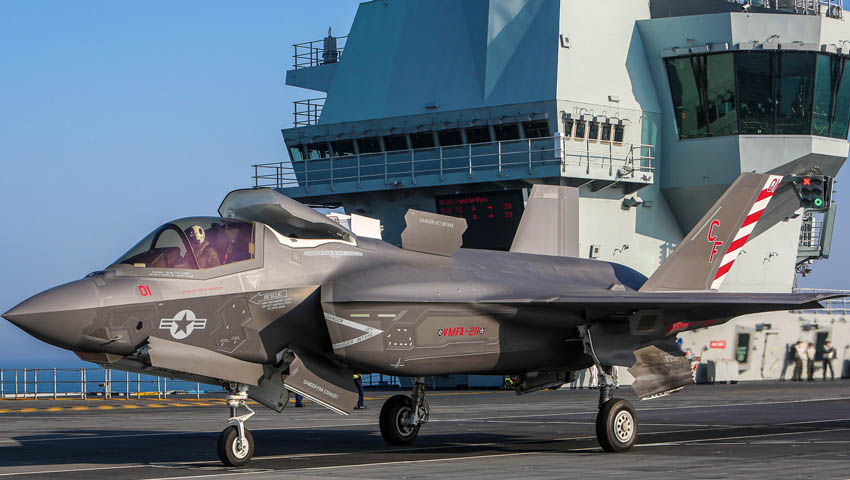The Lockheed Martin-built fighter jet has landed on the HMS Prince of Wales as part of the Royal Navy’s acceptance training.
The Royal Navy’s latest aircraft carrier, HMS Prince of Wales, has hosted a Royal Air Force F-35B Lightning as part of Sea Acceptance Trials conducted off the south coast of England — marking the first time a fixed wing aircraft has touched down on the 65,000-tonne vessel.
The trials are designed to test the ship’s capability to receive and launch aircraft, while also maintaining continuous air operations.
“The vital partnership between HMS Prince of Wales and our F-35B aircraft signifies a momentous milestone in the capability of the fifth-generation carrier, marking another step towards it becoming fully operational,” the UK’s Defence Secretary, Ben Wallace, said.
“The first jet landing is a huge achievement for all involved and showcases the collaboration across the UK Armed Forces and our impressive Carrier Strike capabilities.”
Commanding Officer of HMS Prince of Wales, Captain Darren Houston noted the significance of the milestone in the “re-birth” of Carrier Strike Group operations.
“It is a tangible reflection of the enormous collective effort from the aircraft carrier enterprise to deliver the Royal Navy’s second aircraft carrier,” Capt Houston said.
“I am particularly proud of the contribution made by my Ship’s Company in developing this world leading, sovereign capability and we look forward in earnest to rapidly growing our experience operating the F-35B through further trials and training later this year.”
The fighter jet’s historic landing aboard the vessel was operated by a pilot from the Royal Air Force’s 207 Squadron.
“It was a real honour to be the first pilot to land the F-35B onboard HMS Prince of Wales,” Squadron Leader Will said.
“With all the training that we have previously undertaken with HMS Queen Elizabeth, we are now looking forward to using that experience and knowledge working with HMS Prince of Wales as she moves towards her full operational capability.”
HMS Prince of Wales left her home port of Portsmouth at the end of April to conduct operational training, which has also included exercises alongside helicopters from the Royal Navy, British Army and RAF.
The vessel has been built to host up to 36 F-35B aircraft, along with a crew of approximately 1,600 personnel.
This capability has been demonstrated by the Royal Navy’s flagship vessel, HMS Queen Elizabeth, which is currently carrying a fleet of F-35Bs as part of Carrier Strike Group 21’s deployment.
HMS Queen Elizabeth is leading six Royal Navy vessels, a Royal Navy submarine, a US Navy destroyer and a Dutch frigate on a seven-month deployment through the Mediterranean, Indian Ocean and Indo-Pacific.
The fleet is carrying approximately 3,700 personnel and 32 aircraft, which include F-35B Lightning fighter jets and Royal Navy Merlin helicopters.
The Carrier Strike Group is expected to interact with over 40 nations during its 26,000-nautical-mile deployment, undertaking over 70 engagements, exercises and operations with allied forces.
These engagements will include participating in NATO’s Exercise Steadfast Defender, supporting the Alliance’s Operation Sea Guardian, and conducting maritime security operations in the Black Sea.
The deployed force will also be joined by French Aircraft Carrier Charles De Gaulle for dual carrier operations in the Mediterranean.
While deployed in the Indo-Pacific, the Carrier Strike Group is scheduled to visit India, Japan, the Republic of Korea and Singapore, in a bid to strengthen security relationships, reinforce political ties and support Britain’s exports and international trade agenda.
Elements of the Carrier Strike Group will also participate in Exercise Bersama Lima — marking the 50th anniversary of the Five Powers Defence Arrangements between Malaysia, Singapore, Australia, New Zealand and the UK.
[Related: Carrier Strike Group commences historic deployment]









